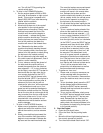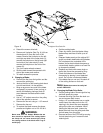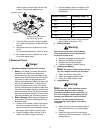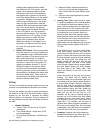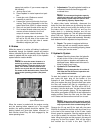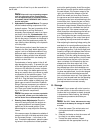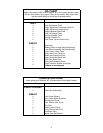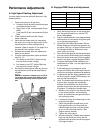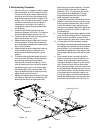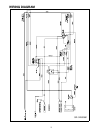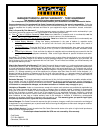21
necessary until the oil level is up to the second hole in
the fill tube.
Note:
After unit is up to operating tempera-
ture, turn off engine and re-check hydraulic
oil. If oil appears foamy or contains excessive
air bubbles, DO NOT OPERATE UNIT. Contact
service technician.
3.
Hydrostatic Pumps and Motors:
The pumps
are the hardest-working components in the
hydraulic system. They are in operation all the
time the engine is running. Because of
extremely close tolerances, wear is an impor-
tant factor in their life.
Contaminants
in the
hydraulic oil and
cavitation
does the greatest
harm to the pumps. Cavitation is a blockage in
the supply lines that produces a partial vac-
uum causing violent bubbling in the hydraulic
oil in the pump.
Check the two suction hoses (the hoses con-
nected to the filter) daily before starting the
engine. Look for a flattened condition or any
leaks and repair or replace as necessary. A
flattened or leakng suction hose will permit
cavitation to develop which can destroy the
pumps in a short time.
Contaminants or foreign matter in the oil will
also damage the pumps . To prevent this, use
a filter that captures particles as small as 30
microns or 30 millionths of a meter in diame-
ter. You can help in the battle against dirt by
being very careful when you remove or repair
a component in the hydraulic system. Thor-
oughly clean off any component before you
work on it. Plug the ends of any hose or line
you remove with a rubber or plastic plug. Use
plastic caps to seal off the ends of hydraulic
fittings. Place any component you remove in a
clean plastic bag so it can’t pick up dust or
dirt. Clean your hands frequently when work-
ing on the hydraulic components.
Note:
The pumps are not owner-repairable.
If a pump fails, contact your Cub Cadet Com-
mercial dealer. Do not disassemble the pump.
4.
Steering Lever Adjustments:
Place the
mower on level ground with the engine run-
ning, parking brake off and steering levers
opened out to the neutral position. If the
Mower begins to creep, adjust the Steering
Levers.
If the mower creeps, first determine whether it
creeps to the right or left side and which direc-
tion the mower moves — to the front or the
rear. To make the adjustment, place the steer-
ing levers in the opened-out neutral position
and set the parking brake, shutoff the engine,
take the key from the ignition switch and pivot
the seat forward. If the mower creeps to the
right, you will adjust the linkage on the left
side of the mower and vice-versa. Remove
the cap screw and lock washer that secure
the linkage control arm rod end bearing to the
control lever pivot. Loosen the jam nut which
prevents the rod end bearing from turning. If
the mower creeps forward, thread the rod end
bearing one-half turn clockwise into the link-
age control arm. If the mower creeps back-
ward, thread the rod end bearing one half turn
counterclockwise out of the linkage control
arm. Then tighten the jam nut and reconnect
the rod end bearing to the control lever pivot
by replacing the cap screw and lock washer.
After adjusting the steering linkage, swing the
seat back to its normal position and place the
steering lever on the side you adjusted up to
the operating position. If you feel a slight push
forward or a slight pull backward from the neu-
tral position you must adjust the lever return
assembly. To do this, swing the steering lever
back out to the neutral position, pivot the seat
forward and loosen the jam nut on the lever
return rod where it is threaded into the hex-
shaped end of the lever return bolt. If the
steering lever was pushed forward, turn the
hex-shaped lever return bolt clockwise one-
half turn off of the lever return rod. If the steer-
ing lever was pulled back, turn the hex shaped
lever return bolt counterclockwise one-half
turn onto the lever return rod. Then tighten the
jam nut, pivot the seat back into the operating
position and start the mower to check that
your adjustments were made correctly.
G. Storage
1.
General:
If your mower will not be in service
for a few months, it should be stored in a dry
location that is not subject to drastic changes
in temperature. Before storing, the following
maintenance procedures should be per-
formed.
Note:
For E.F.I. Tanks, disconnect the neg-
ative lead of the battery for storage of 4 weeks
or more.
a. Clean the mower. The entire tractor and
cutting deck should be washed and
cleaned.
b. Sharpen the blades so that the mower will
be ready to use when needed.
c. Protect the metal surfaces. Repair
scratches with the appropriate touch-up



